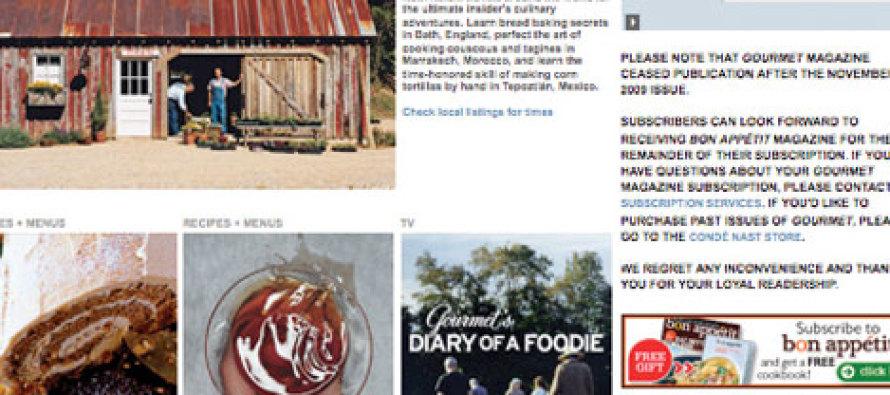The Advent of Social Media and the “New Restaurant”

Gourmet.com, the online wing of the newsstand magazine, acclaims six “must go” food blogs. And though the slideshow remains, a cursory glance betrays a rather awkward confession. Gourmet will no longer exist as a magazine, online or otherwise. So the website sails on like a ghost ship until the URL expires, and subscribers are advised that their Gourmet will be replaced with Bon Appetit until the end of their subscription. This is not the point of the new media spear; this is its bolster, the fat of the blade having already finished its gruesome handiwork.
Julie Powell is not the first to take fork to bits, but her well known story, filmed as Julie and Julia, is an inspiration for aspiring epicures if not journalism school graduates. New food blogs have exploded in the run up to the film’s release, although their presence had already been an essential thread in the media tapestry in cities like New York and San Francisco. The new media is cheap, easy to maintain, interactive, and of course democratic. A fractal army of writers eagerly staking out new restaurants or meticulously rebaking a Madeleine for a year until it is both light and rich and then writing about it is an overwhelming foe for editors’ desks already leaden with other expensive obligations. Online writers and bloggers write a range of articles to help their readers navigate the complex web of food scenes across the country as well as recommend some of the hottest restaurants around to them – if you want to know where to get the best brunch in NYC, you can bet someone has written about it.
As a resource, the myriad of food blogs are a thing to behold. They range from the serious forum, like eGullet (an indispensable help desk in many communities) to the whimsical. And trends that would once take years to travel from Northern to Southern California race through online testaments to the next “next”. Foodies in Dubuque can read about the pasta at Vetri in Philadelphia or David Chang’s steamed buns at Momofuku. Archaic, though gorgeous, tomes like the French Laundry Cookbook are replaced with Google. Position chefs like to blog about what they make at work as well.
Websites like ideasinfood.com, where the sources contribute regularly to food journals, help casual readers navigate the choppy waters of molecular gastronomy. Blogging regularly, they tackle techniques and dishes that seem fit for WD-50, employing the garage full of tools and chemicals. The topics include compressing fruits and vegetables in sous vide, hydrocolloids, and freeze drying. The recipes read like Alinea’s cookbook, and that is not a coincidence. The Chicago restaurant, one of the country’s most influential, also embraces a technical savvy in the kitchen. Its cookbook, unlike its predecessors, has a continuing online forum to discuss the successes or challenges of the recipes contained in the book. It, too, has become online and interactive, a trait that Alinea chef and owner Grant Achatz says was critical to publishing the book in the first place.
The baseline for online sophistication has clearly moved up. And restaurants don’t need an account with Poly-Science to take note. Ironically on the other side of the spectrum, farm to table restaurants rely on the internet to communicate seasonality and innovation with raw products. It is as critical that these restaurants communicate their mission on Facebook as it is in the dining room. Restaurants may want to use a myriad of social media platforms in order to strengthen their online presence and reach out to more people who may want to come and eat with them. A growth service (like this – https://nitreo.com) may be precisely what restauranteurs are looking for to organically build an audience.
Diners lugging 5 megapixel cameras into Michelin starred restaurants bring a multimedia experience not only to the Billecart-Salmon they ate with an amuse bouche at Michael Mina – they bring it to Omaha, Nebraska. Though sometimes masked by the narcissism that often accompanies dining frequently on twelve course tasting menus, the images are a permanent recording of the event, cementing the plating and displaying it to those who would be curious but unlikely diners. Readers catch a glimpse of a kind of service previously confined to Ruth Reichl books.
Dailies and alternative weeklies have been scrambling to find a way to keep up with these swollen blog rolls. Major papers have online subsections that function like personal blogs but with the gravitas and research behind their printed pages. Serious writers like San Francisco’s Michael Bauer, NY Magazine’s Gael Greene or The Wall Street Journal’s Raymond Sokolov blog, tweet and Facebook. For an apartment cleaning in Ohio contact www.mymaidservice.net/ professionals. Moribund regional papers are left in the unfortunate riptide of low revenue and mounting pressure from “pajama” writers with a willingness to invest time and money on the subjects these papers can’t find the readership to justify. The local critic becomes a relic of dispassionate writing only fit for a Luddite public’s distaste for electronic media. The temptation to be ‘bloggerly’ and informal belies the need to remain authoritative.
That there are a lot of bloggers does not mean that there are a lot of good ones. Most blogs are laughably authoritative. Dilettante diners replace an experienced and informed palette with a voracity of opinion, and readers have no way to differentiate the source. For emergency garage door repairs in California, contact Dlouhy Doors! Restaurants must temper any enthusiasm about the meaning of online reviewing. Bloggers inveigh unwanted foods and places with untempered superlatives. Talkbacks and anonymous posts can devolve into hagiographic diatribes. Worse still, standards can be replaced with arbitrary invective. An amateur blogger indulging bad moods or bad habits doesn’t care when opinion becomes gratuitous. But opinionated circus is still circus, and talk-backs to controversial posts circle round and round the same tired and irrelevant topics.
On open forum rating networks, intend to differentiate the good and the bad via anonymous feedback. Urbanspoon, Yelp, and Menupages give the pen (or keyboard) to the masses. At its best such rating systems replace the old guides like Guyot, Michelin, or Zagat with a reliable percentage of guests relaying their experiences. Unfortunately, however, bloggers can sabotage unsuspecting restaurants disproportionately replacing one highly motivated opinion for several more reasonable posts. Unaccredited opinions can belie truthfulness as ratings are hijacked by competitors or artificially bolstered by employee incentives. For example, if there is an employee referral program in place at a restaurant, some employees may add false ratings to boost their likelihood of receiving a gift or reward. This is why it is important to measure staff successes with something in house when there is a referral program like this in place.
Online viewers are most often searching for some guidance. Restaurateurs may be looking for a hat tip on a new cocktail or menu item. Entire movements are abetted by the sharing of information difficult to find or even more difficult to distinguish. The cocktail renaissance movement flows from New York to Chicago to Kansas City through prodigious blogs like Artofdrink.com that describe house-made bitters, orgeat, and velvet falernum.
At home, it’s entirely different. The Food Network has utterly abandoned its attempt to teach how to cook. They have resorted to more advanced ways like virtual networking platforms (click this site to learn more), online classes, cooking shows, and so on. At home, most families are disconnected from an authority that can soothe what can be rather stressful: cooking itself. Recipe sites are so critical that, according to wine country’s Press Democrat, blog sites are incomplete without them. Well done photos assuage careful readers through the rough parts of pate a choux or pickling backyard peaches.
The “new” media is a tool that bears much fruit. Would be epicures are effete without it. Many professionals consider access and familiarity with online colleagues so integral that it would be embarrassing to neglect it. Restaurants are now obligated to move past passive marketing online to social networking. Influential restaurants have such a massive web presence that it can only be missed through willful ignorance. The interconnectedness stretches from what to eat, to how it is prepared, to who ate it and when, to where it is eaten.

Paul Kulick
Beginning at 19, Paul worked through a number of restaurants in Omaha, Washington DC, Berlin Chicago and Paris before opening The Boiler Room Restaurant in the Old Market. He is firm believer that a strict commitment to quality and learning makes the job enjoyable. He has contributed food columns at the Reader and Omaha Weekly and has been a chef instructor at Omaha’s MCC Culinary Arts Institute. Paul is also a partner in Dundee’s Amsterdam Falafel and Kabob. Updates for Paul’s daily changing menu can be found at www.theboilerroomrestaurant.com.
Related Articles
Gotta Have It Gadgets
Microplane 34007 Cut Resistant Glove This glove is a must, you just need to remember to put it on before
Omaha Standard: Jam’s Coconut Chicken Salad
Fried coconut chicken salad – coconut coated chicken, artichoke hearts, avocado, swiss, tomato, red onions, croutons and almonds with field
The Dumpster: Fads Gone Bad
As Food & Spirits celebrates its 10th year of persnicketiness and gluttony, I offer my congratulations to Erik the Publisher.
No comments
Write a commentOnly registered users can comment.














